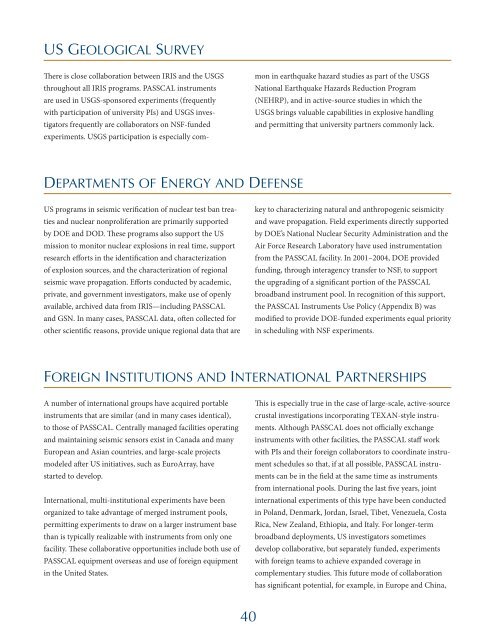Download 9.3 Mb pdf - IRIS
Download 9.3 Mb pdf - IRIS
Download 9.3 Mb pdf - IRIS
Create successful ePaper yourself
Turn your PDF publications into a flip-book with our unique Google optimized e-Paper software.
US Geological Survey<br />
There is close collaboration between <strong>IRIS</strong> and the USGS<br />
throughout all <strong>IRIS</strong> programs. PASSCAL instruments<br />
are used in USGS-sponsored experiments (frequently<br />
with participation of university PIs) and USGS investigators<br />
frequently are collaborators on NSF-funded<br />
experiments. USGS participation is especially com-<br />
mon in earthquake hazard studies as part of the USGS<br />
National Earthquake Hazards Reduction Program<br />
(NEHRP), and in active-source studies in which the<br />
USGS brings valuable capabilities in explosive handling<br />
and permitting that university partners commonly lack.<br />
Departments of Energy and Defense<br />
US programs in seismic verification of nuclear test ban treaties<br />
and nuclear nonproliferation are primarily supported<br />
by DOE and DOD. These programs also support the US<br />
mission to monitor nuclear explosions in real time, support<br />
research efforts in the identification and characterization<br />
of explosion sources, and the characterization of regional<br />
seismic wave propagation. Efforts conducted by academic,<br />
private, and government investigators, make use of openly<br />
available, archived data from <strong>IRIS</strong>—including PASSCAL<br />
and GSN. In many cases, PASSCAL data, often collected for<br />
other scientific reasons, provide unique regional data that are<br />
key to characterizing natural and anthropogenic seismicity<br />
and wave propagation. Field experiments directly supported<br />
by DOE’s National Nuclear Security Administration and the<br />
Air Force Research Laboratory have used instrumentation<br />
from the PASSCAL facility. In 2001–2004, DOE provided<br />
funding, through interagency transfer to NSF, to support<br />
the upgrading of a significant portion of the PASSCAL<br />
broadband instrument pool. In recognition of this support,<br />
the PASSCAL Instruments Use Policy (Appendix B) was<br />
modified to provide DOE-funded experiments equal priority<br />
in scheduling with NSF experiments.<br />
Foreign Institutions and International Partnerships<br />
A number of international groups have acquired portable<br />
instruments that are similar (and in many cases identical),<br />
to those of PASSCAL. Centrally managed facilities operating<br />
and maintaining seismic sensors exist in Canada and many<br />
European and Asian countries, and large-scale projects<br />
modeled after US initiatives, such as EuroArray, have<br />
started to develop.<br />
International, multi-institutional experiments have been<br />
organized to take advantage of merged instrument pools,<br />
permitting experiments to draw on a larger instrument base<br />
than is typically realizable with instruments from only one<br />
facility. These collaborative opportunities include both use of<br />
PASSCAL equipment overseas and use of foreign equipment<br />
in the United States.<br />
This is especially true in the case of large-scale, active-source<br />
crustal investigations incorporating TEXAN-style instruments.<br />
Although PASSCAL does not officially exchange<br />
instruments with other facilities, the PASSCAL staff work<br />
with PIs and their foreign collaborators to coordinate instrument<br />
schedules so that, if at all possible, PASSCAL instruments<br />
can be in the field at the same time as instruments<br />
from international pools. During the last five years, joint<br />
international experiments of this type have been conducted<br />
in Poland, Denmark, Jordan, Israel, Tibet, Venezuela, Costa<br />
Rica, New Zealand, Ethiopia, and Italy. For longer-term<br />
broadband deployments, US investigators sometimes<br />
develop collaborative, but separately funded, experiments<br />
with foreign teams to achieve expanded coverage in<br />
complementary studies. This future mode of collaboration<br />
has significant potential, for example, in Europe and China,<br />
40

















